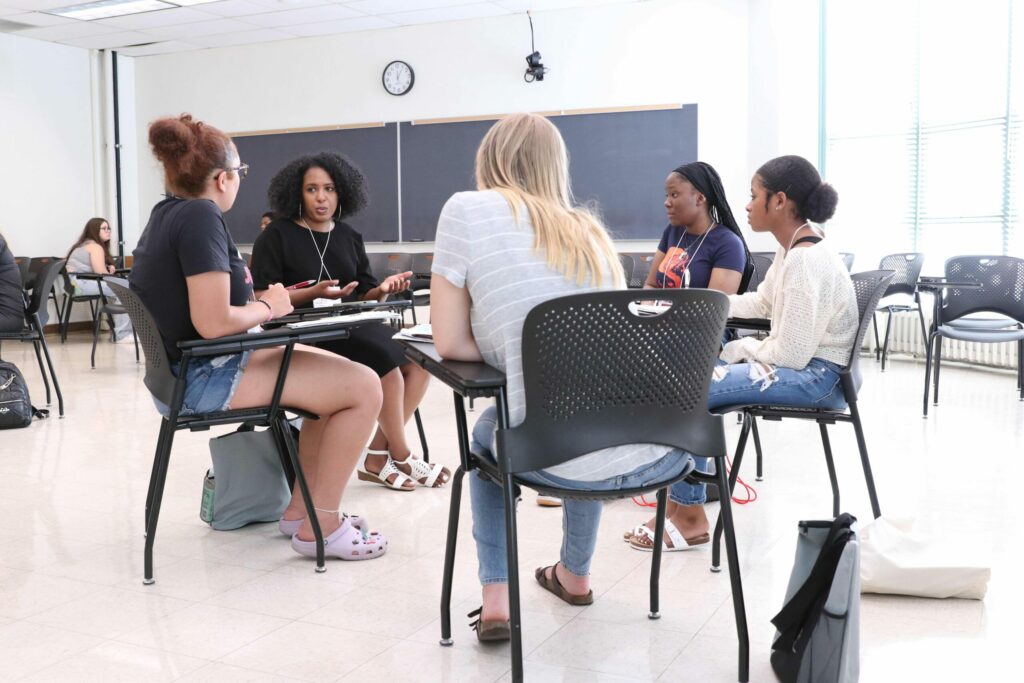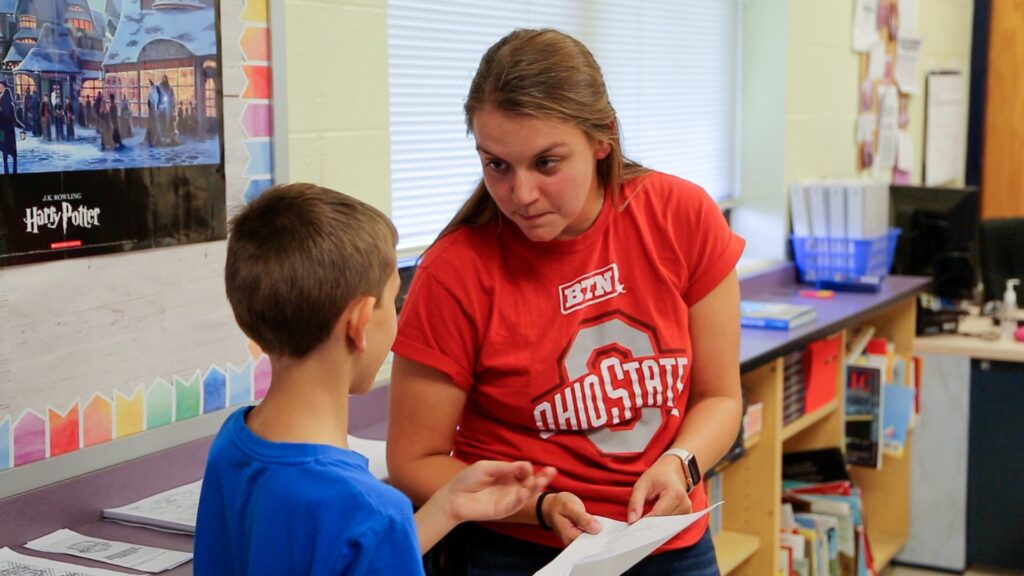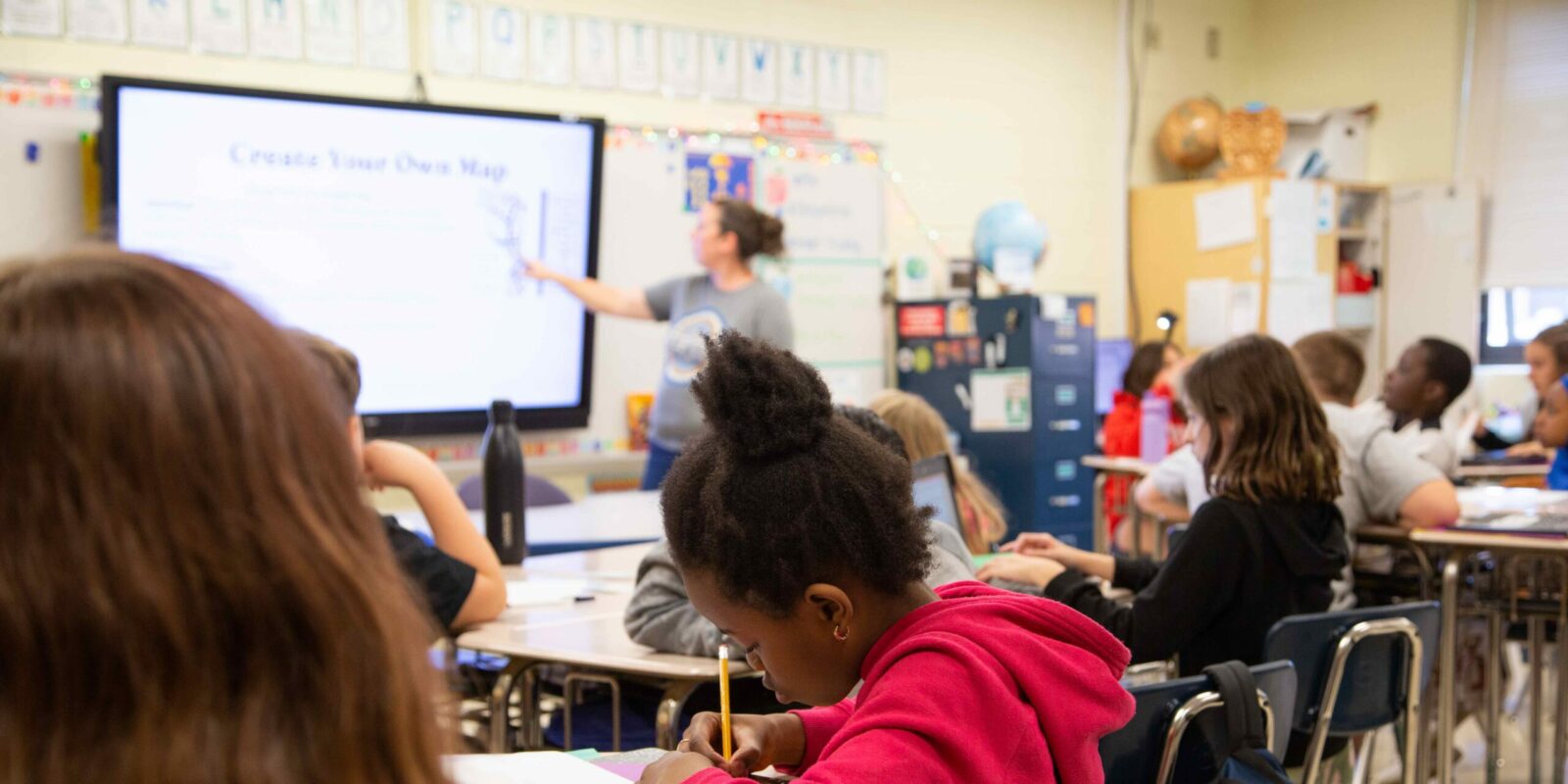As warnings of catastrophic teacher shortages began making headlines in autumn 2021, all eyes were homed in on teachers like Mary Hippler. The 2020 graduate of Ohio State’s College of Education and Human Ecology spent her first year of professional teaching maneuvering the chaos of a pandemic, conducting hybrid classes in two-day splits with her fifth-grade students.

“I was just going with the flow,” she said. “It was a stressful situation. But I felt like that’s how I could best support my students. I just tried to go with it.”
The next year, though, brought significant challenges. The scenario in Hippler’s classroom played out across America: Hybrid classes were over. Kids were behind academically and struggled to focus. Behavioral problems disrupted learning. Some students lamented to Hippler that they didn’t want to be at school at all.
There would be days like this, her professors had told her. For some teachers that year, there were many such days.
“I tell my students often: Teaching is not for the faint of heart,” said Clinical Associate Professor Tami Augustine, who directs accreditation, placement and licensure for the college. “You have to know your ‘why.’ What’s your deep, meaningful why? So that on terrible days, you can remember.”
Even before the pandemic, 44% of teachers left the profession in their first five years, research shows. Whether early-career teachers like Hippler choose to stay in the profession or abandon it depends on a host of factors. The college and its experts are doubling down to understand those factors, to keep teachers in classrooms and help more to answer the essential call of educating America’s children.
Here are five steps the college is taking to combat teacher shortages.
Leading the conversations
On Nov. 3, the college will host a regional meeting, one of five across Ohio, to advise the state on how to respond to growing teacher shortages. Sponsored by the Ohio Department of Higher Education, the meetings will bring together teacher education program faculty from Ohio colleges and universities, school leaders and community representatives to plan steps forward.

The college’s Dean Don Pope-Davis and Chief of Staff Nicole Luthy serve on an Ohio Department of Higher Education task force to examine why teachers are quitting, and how to stop what experts call “the churn” — educators going in and out of the system.
“This is the first year in my 31-year career that I’ve heard schools say we’re having trouble filling elementary positions,” Luthy said. “We know that there are some areas where the challenges are more acute,” such as special education and middle- and high-school science and math. Schools serving low-income rural and urban communities are bearing the brunt of those shortages.
One topic certain to be discussed at the meeting is teacher pay. The Public Policy Institute in August released a report showing that American teachers on average earn nearly 24% less than comparable college graduates. Ohio teachers fared slightly better, making 14.4% less than other Ohio college grads.
“The financial penalty that teachers face discourages college students from entering the teaching profession and makes it difficult for school districts to keep current teachers in the classroom,” the report said.
By convening school administrators, policymakers, researchers and educators, the task force hopes to issue recommendations to encourage regional and state-level investments to curtail the shortage.
“This is the moment,” said Dean Don Pope-Davis, “when we as educators are called upon to lead and demonstrate that we are capable of transforming our thinking so that new possibilities emerge.”
Making degrees more accessible
The college has done extensive work to remove barriers that keep students out of teaching programs. In autumn 2021, most of the college’s teaching and learning programs for the first time began directly admitting first-year and transfer students.
“The advantage of direct-admits is that we can follow them,” said Antoinette Miranda, chair of the Department of Teaching and Learning, who pushed for the change. “So, if they get in trouble academically, we can work with them to see if we can provide resources and assist them.”
The strategy appears to be working. Even though college enrollment has dropped nationwide, this year’s P-5, elementary education cohort in Miranda’s department is the largest since the program began in 2012, with more than 400 students. Once students are admitted, the department uses data to closely monitor their progress.
“We’re identifying barriers,” such as difficult math classes, “that may have students drop out of teacher education or keep them from progressing in teacher ed,” Miranda said.
Offering targeted support to transfer students and reducing “curriculum bloat” will help students to graduate in four years instead of five. Scholarships can cover costly fees for licensure tests. Those reduce cost barriers for students and get them into classrooms sooner.

Growing our own
Ohio has 12,000 fewer public-school teachers today than in 2009, according to a 2022 report by the Thomas B. Fordham Institute. The problem of teacher retention is not new.
Of roughly 100,000 teachers in Ohio public schools today, nearly 92% are white and 75% are women. Meanwhile, nearly one-third of Ohio public schoolchildren are non-white.
“In particular, when we think about people of color, they tend to exit the field at a higher and higher rate,” said Jenell Igeleke Penn, assistant clinical professor of teaching and learning.
When Penn ran into a Black high schooler she knew on campus, it sparked an idea. The student was at Ohio State to attend a Columbus City Schools teacher academy class that met in Arps Hall.
“Their coming here is great, but they weren’t coming to our classes,” Penn said. “They were not meeting faculty or staff and weren’t meeting students. What can we do to strengthen the connection that we have between the teacher academy and Ohio State?”
Penn now directs recruitment, mentoring and diversity retention efforts for the college. In June, she and others launched their own three-day teacher academy for high schoolers. Project ROOT: Reaching Our Own Through Teaching led workshops on college admissions and taught sample classes to the diverse group of teenagers. It got kids on campus and in front of professionals who offered teaching-career advice.
“We talked about using your voice,” Penn said, “and educators who use the classroom to hold space for student voices. We talked about what their experiences have been. I think just seeing all the different (facets) of education changed how the students felt about education.”
The program will expand next year; Penn hopes to incorporate overnight campus stays. She and Miranda believe that connecting early will encourage more and diverse students to apply. And connecting with them consistently — well into their careers — will impact whether they stick with the profession.
Research that addresses problems
When teachers are asked why they leave the profession, common themes emerge: Low pay. Burnout and stress. Long working hours. Also among their top reasons for quitting? Not seeing eye to eye with school administrators.
Research by the college chips away at conventional wisdom for educational leadership. A recent study co-authored by Professor Roger Goddard, for example, shows that humble leaders made teachers feel more empowered to share knowledge and take risks.
“A little humility on the part of leaders goes a long way in helping groups be more productive and collaborative,” said Goddard, the Novice G. Fawcett Professor of Education Administration.

The study, which considered leadership styles among professional learning communities, shows that teachers with humble leaders felt their jobs had meaning, their work had impact, and they had autonomy to do their jobs.
Other current studies include one by EHE Distinguished Professor Edward Fletcher about recruiting and retaining Black male STEM teachers, a significant need in American schools. The study will consider the impact Black men have on their ethnically diverse students and what makes those teachers more likely to stay in schools.
A teaching college that is also a research college strives to go further.
“Our goal always is to change education,” said Augustine. “We’re an R1 institution. We want to introduce students to our research, and we want education to evolve. We want it to be better — it has to be better because we know it’s not meeting everybody’s needs.”
Teaching teachers well
But getting education where it needs to be requires well-trained teachers putting research into practice.
“We are very intentional about how we set it up so that students get the theory and research. They get tons of field experience, and that’s a very realistic type setting,” Augustine said. Reflective seminars, where they interact with peers and instructors about classroom experiences, tie all the pieces together. Students create deep bonds with these cohorts and collaborate with them long after graduation.
Most Ohio State teaching and learning students get around 300 hours of field experience — and as many as 500 — in schools or other settings. That’s hundreds more hours than the state requirement of 100. The First Education Experience Program, required for most majors, introduces students to classrooms in year one.
“Before they’ve even started the bulk of their education coursework, they’ve been exposed to these different settings already,” Augustine said. If students aren’t cut out for teaching, most figure it out right away.
Their training better prepares Ohio State teaching students for what’s to come. Preservice teachers spend hours role-playing classroom management: How to handle the heckler in the back of the class. What to do when a student gets in your face or throws a tantrum. They talk about how the adolescent brain pushes kids to rebel. Most importantly, preservice teachers learn to build collaborative classroom environments that nip behavior issues in the bud.
“We’re asking (children) for their input; we’re treating our young people like young people, not like little kids who know nothing. So let’s create a classroom environment together. We’re focusing a lot on community building and team building in ways that are meaningful,” Augustine said.
Mary Hippler’s fifth-grade language arts and social studies lessons are interactive. They incorporate Augustine’s magic ingredient of “joy and humor.” Hippler’s instructors at Ohio State taught her that an engaged student is a learning student.
“(My professors) expect creativity in their lessons,” Hippler said. “They expect incorporation of student interests and culturally sustaining pedagogy that engages students. That is meaningful to students and it’s meaningful to teachers and thus creates deeper relationships with teachers and students. And I think that makes it easier to have their respect and their attention during lessons. Mediocrity wasn’t what we were striving for.”
Going that extra mile pays off. Districts consistently tell Augustine and her team that Ohio State students are the best prepared teachers, the ones they want to interview first. When Hippler’s administrators observed her teaching, they said the learning in her class was so meaningful, they would be honored if their own children were taught by her.
Knowing their ‘why’
Teachers become teachers because they love kids. During the tough times, that’s not enough. So Ohio State instructors press, why do you want to be a teacher?

“I need you to dig deeper than ‘to make a difference,’” Augustine tells them. “What specifically do you want to do here? We spend a lot of time processing that and talking about that. It keeps them really grounded, so they keep coming back to that.”
During Hippler’s tough second year, she dug into her why. She chat-messaged her Ohio State cohort for more ideas on how to cope with behavior problems. She collaborated on solutions with teachers in her school. She tried new things.
“I struggled to build relationships with (certain students) for a long time,” she said. “It took a lot of chipping away.”
She didn’t give up. Now those kids have moved on to sixth grade.
“The students that said every day, ‘I don’t want to be at school,’ they come in every morning and give me a hug,” Hippler said. “I’d like to think that I help them want to be in school. And I guess that’s my why.”

